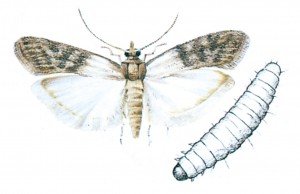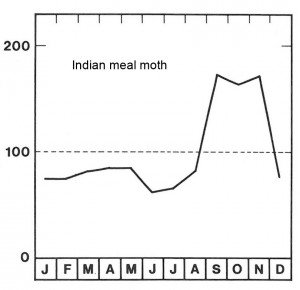
Latin: Plodia interpunctella.
A beautiful little moth with eye-catching colours. The elytrons’ inner third is light gray, while the rest is reddish brown. The larvae are yellow-white with dark brown heads. The larvae are 12 – 13 mm long when ready for pupation. The Indian meal moth probably originated from Europe, but can now be found everywhere. The moth is a troublesome pest in warm countries, especially in places with dried-fruit industries. The larvae damage dried fruit, nuts and almonds, and exceptionally cereals and cereal products. The larvae sometimes occur as “worms” in chocolate.

The female begins to lay eggs three days after the change to the adult moth. Over the next 14 days she lays about 500 eggs. The development time from egg to adult depends on food and temperature. Under optimal conditions at 25 °C, it takes just 35 days to fully develop. In unheated warehouses, progress is slow, and may only produce two generations per year. Larvae ready for pupation often crawl far away from whatever they matured in. The pupa, which is approximately 7 mm long, is completely entangled in a rather thick, white silk cocoon.




